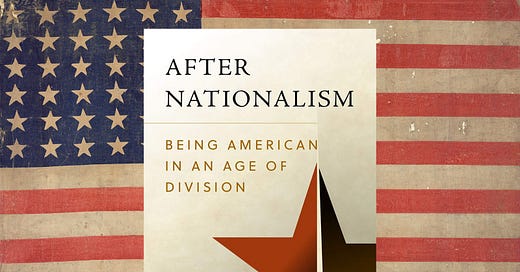
A Nationalism of Community
Nationalism in America is messy and paradoxical—and needs a new emphasis.
After Nationalism Being American in an Age of Division by Samuel Goldman University of Pennsylvania, 148 pp., $24.95
Nationalism, at its best, is a source of cohesion. When “nation” refers to a people, nationalism can bind them together even when they are dispersed across many lands or when they feel insecure within a land. When “nation” refers to a sovereign country—the understanding used in this essay about America—nationalism can bind individuals together at the level of the state.
National unity is most easily accomplished, and is at its stickiest, when a nation-state faces ominous outside forces. Its people can be tightly connected when external threats arise: when hostile troops amass on their borders, when their economic standing is undermined by international competitors, when their ways of life are challenged. In such circumstances, people are likely to get clear about who they are—we are in peril—and what they will do about the threats they face.
Outward-facing nationalism can go astray in a number of ways. It can result xenophobia, international belligerence, and imperialism. But it is also connected to the protection of national sovereignty, territorial integrity, and vital economic and security interests.
Absent external pressure, the cohesive powers of state-based nationalism must be found internally, namely in what the people have in common—what constitutes the “we.” Historically, this has been found in blood, soil, throne, or altar. The people share a lineage, a longstanding home, a commitment to a sovereign, or a faith. But what happens when a nation can’t rely on these—when its people don’t descend from the same line, haven’t been tied to a geography for millennia, aren’t bound to a powerful ruler, and don’t worship in the same way? Indeed, what happens in a highly diverse, continental republic conceived in liberty—one whose people differ greatly and jealously guard what makes them different? Cohesion can be elusive, and even the attempt to forge cohesion at the national level can clash with particulars that people find meaningful.
Americans have found two ingenious solutions. The first is a set of narratives about who we are vis-à-vis other nations so that, even when external threats are minimal, we distinguish ourselves. This is the land of opportunity, a shining city on the hill, home of the American Dream; we believe that all are created equal, that we have a manifest destiny, that we are the last, best hope. The second is a set of practices that enable us to live with our countless differences. We deliberate and form consensus through democracy; we foster community through varied voluntary associations; we protect individuals from coercion through rights; we preserve different customs and visions of the good life through federalism and localism.
So, like other nations, our nationalism is partially rooted in stories about ourselves and in externally minded factors (like territorial integrity and national economic interest). But our nationalism, unlike that of most other nations, is also rooted in a collection of processes related to public life. That is, American nationalism includes a commitment to the very systems that enable vastly different people to debate, dissent, negotiate, exercise freedom, and protect particularism so we are able not just to coexist but also to collaborate for the common good.
One result of this unusual type of nationalism, is that conservatism and nationalism in the United States have a very different relationship than in much of the rest of the world. Conservatism elsewhere is often associated with the preservation of centralized state power—maintaining the state religion, the authority of the monarchy, state-owned industries—or the singular identity of the population. In America, somewhat paradoxically, conservatives generally aim to strengthen the nation by decentralizing power. American conservatives understand the necessity of preserving the authority of states, counties, towns, community-based organizations, and local businesses.
Also, because America’s national heritage includes the practices that enable our citizens to resolve and live among difference, American conservatives have procedural commitments alongside their substantive commitments. So, for instance, the American conservative will have policy priorities related to the family, human dignity, bootstrapping, immigration, tax rates, law enforcement, and the size of government. But the American conservative will also have beliefs about self-rule, the separation of powers, decentralization, the rule of law, pluralism, and liberty. As a result, an American conservative may, for instance, feel strongly about K-12 education policy but not want those views mandated by the federal government; she may have a firm position on the proper income-tax rates but not want judges to read those views into the Constitution; she may want to see particular housing and transportation reforms but not want those brought to life by a gigantic, unelected, unaccountable administrative state; she may support tougher sentencing guidelines but she will defend an opponent’s free-speech right to express a contrary view.
For the American conservative, advancing the national interest demands concern for both the what and the how of governing.
Samuel Goldman’s studied, level-headed After Nationalism is interested in the “how” of American unity, seeing the building of solidarity as a continuous, often contentious process. He argues that in the contemporary United States the systems for generating cohesion deserve our attention. The discussion of nationalism always excites the passions, meaning it can be difficult for those who disagree to make much headway. Goldman’s astute argument and low-voltage tone make After Nationalism the rare conversation-starter among a mountain of conversation-enders.
We Americans disagree with one another on the fundamental questions of what America is and what it means to be an American. Yet if we’re to avoid perpetual conflict, there must be some unum among our pluribus. “Surely residents of the same places, subject to the same laws, must share some answers to the question of who we are,” Goldman writes.
We might unite around a set of common values related to how we live together—“rules of coexistence for people who otherwise don’t share much,” Goldman writes. These rules aren’t merely statements of bland consensus—like appreciating the meaning of Thanksgiving or believing in opportunity. They are procedures for handling our inevitable disputes. These give us “a way of governing” apart from loyalty to ethnic groups or religious affiliations. Goldman proposes that “we strengthen institutions of contestation” so we can defend our particular policy positions and visions of the good life without coming to blows. Such institutions channel disagreements into compromises and offer protection for those who lose political contests. The alternative, he rightly notes, is a kind of forced consensus that aggravates our differences. “To the extent that nationalism involves centralization and homogenization, it can exacerbate the disorders it purports to solve.”
This systems approach to understanding America isn’t novel as Goldman points out: Prior to the twentieth century people commonly described America as “the republic” or “the union,” signifying the central role of our governing structure. But Goldman is also clear-eyed about the risks of relying too much on “constitutional patriotism.” For instance, research shows that diversity can erode confidence in the institutions designed to mediate our differences. A nationalism of procedure when differences abound is a “high-stakes bet.” There might well be limits to the amount and severity of disagreements that our institutions can resolve or at least temper. But complementing “institutions of disagreement” with localism and voluntary association, Goldman believes, may help.
In practice, America doesn’t bank solely on citizens’ loyalty to abstract ideas or distant institutions. Instead, Americans live in neighborhoods and towns, they are members of local groups and religious organizations. At the national level, our differences stand out; at the level of kin, village, and association, much greater unity of purpose is possible. Therefore, understanding America as a “community of communities” is key. Indeed, on the book’s final page, Goldman appears to side with those who believe American harmony is, or could be, the upshot of its citizens’ participation in an array overlapping groups and our institutions’ ability to settle the resulting conflict. Or, as I would put it: While other countries build cohesion at the national level, our national commitment to decentralization and liberty plus Americans’ inclination for forming associations enables us—perhaps in a sense requires us—to build solidarity close to home.
Goldman reaches his conclusions after surveying centuries of America’s efforts at unity. Though a small book, After Nationalism is dense with examples of the ideas and events that aided or inhibited our ability to find common cause.
Goldman’s history is built around three concepts: covenant, crucible, and creed. The covenant theory of nationalism is basically religious, holding that America’s beginning reflects a relationship between the Anglo-Protestant settlers and God. The crucible sees an ongoing process of melting down ethnic and cultural differences to form a single, strong American alloy. The creed is more of a political philosophy; the nation has central beliefs (for example, related to equality and the rule of law) and institutions that bring them to life; anyone embracing the creed, regardless of origins, can make an equal claim on the nation.
The covenant model is the earliest, reflecting both the motivations of those who first came to these shores and the fact that America’s Northeast had remarkably little diversity for generations thereafter. New England had been settled by intact families that produced a large native-born population; the area received relatively few immigrants for two centuries after 1640, meaning the local population was “homogeneous, interrelated, and long settled,” mostly coming from British Protestant stock. One can see shades of blood-and-altar nationalism in the covenant.
As the nation expanded and diversified, especially in the era of rapid immigration, the crucible emerged as a way of explaining how the many differences found in the population could still produce national cohesion. However, the view that we were happily, seamlessly becoming one was undermined by instances of racism and nativism in policy and practice. Catholics were viewed with suspicion by many in the nation’s earliest days; slavery demonstrated the nation’s unwillingness in incorporate millions into society; the late nineteenth-century wave of immigration generated backlash toward Italians, the Irish, the Chinese, Poles, Jews, and others—anti-immigration policies, segregation, disenfranchisement, and eugenics.
America turned to the creed to bring more Americans into the national fold while respecting different groups’ distinct cultures and beliefs. The external threat of imperialism, Nazism, and totalitarianism, and then the Cold War and Communism created a national appetite for internal cohesion, which for a time served to both diminish the impulse to “other” Americans with minority faiths and customs and to encourage those groups to integrate into the dominant culture. During this era, fighting authoritarian regimes abroad and advancing equality at home, Americans were repeatedly urged by their leaders to re-embrace the nation’s foundational principles—democracy, liberty, justice, opportunity. The hope was that an America oriented around such beliefs would be able to absorb millions of immigrants, incorporate a sprawling diversity of ways of life, and stay cohesive as the blend of citizens’ backgrounds and customs continuously changed. Indeed, “assimilation” initially meant different groups’ retaining their distinct features while accepting shared norms.
But according to Goldman, the “search for a creedal nation was a failure,” as well. Mass culture pushed aside ancestral languages and traditions. Political clashes over Vietnam, crime, busing, and various social movements clearly demonstrated that even a nation with a creed of generalities could be convulsed by bruising fights about how to live up to and prioritize shared principles. America, it seems, is still searching for the ideas than can bind us.
There are elements of the previous eras of American nationalism that I believe deserve to be recovered, for instance, the conviction that America was and is special; that our national character was shaped by invaluable beliefs about personal behavior, such as republican virtue, the pioneer spirit, volunteerism, and entrepreneurialism; and that there are ways to simultaneously preserve groups’ distinct features while broadly sharing norms and values. But Goldman is right to suggest that what we might call a fourth-wave nationalism is in order, one based largely on strengthening systems of dispute resolution and elevating the role of local democratic action and voluntary association.
Absent massive external threats, we should assume Americans will differ in countless ways and that social unrest will be the result of efforts to force too much consensus. By encouraging citizens to form and join close-to-home groups with particular, even anti-majoritarian, views and to find places to live where shared sensibilities lead to low-temperature democratic politics, we can enable more Americans to build lives consistent with their deeply held principles. At the same time, we should revitalize the institutions and institutional arrangements that allow Americans to live among difference. Democracy, decentralization, modest courts, separated powers, pluralism, and liberty allow opinions to be aired and solutions to be found, minority views to be protected, communities to be formed, and government to be restrained.
Because of America’s unusual founding and principles and the constant change in its population and internal politics, identifying our “we” from the inside will be a challenge for the foreseeable future—a challenge requiring different solutions over time. Given the toxicity of today’s discourse, the polarization of our politics, and citizens’ search for stability and meaning, America needs a nationalism of community.










